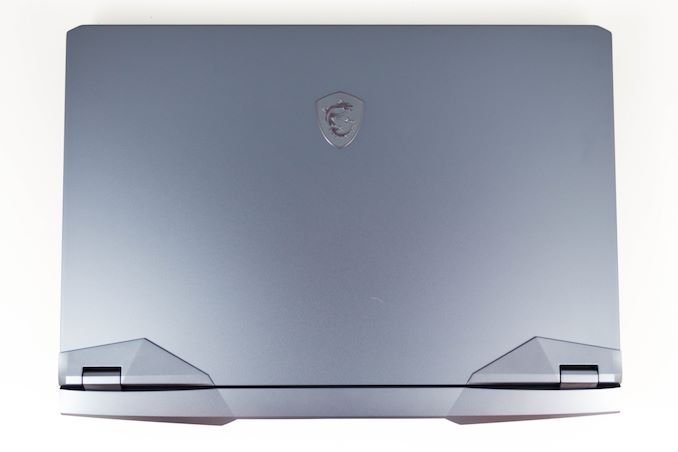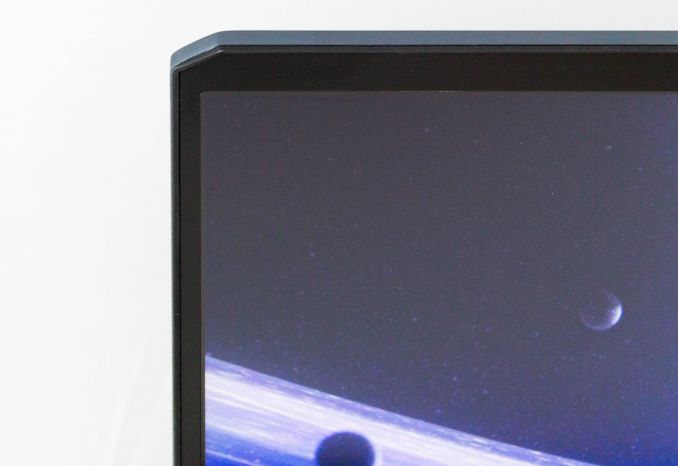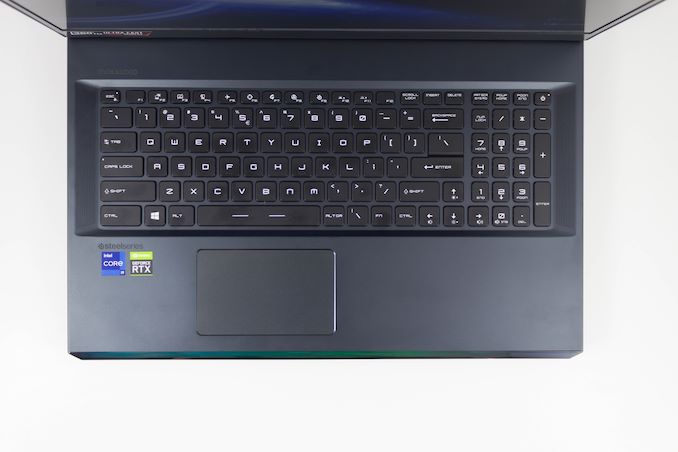The MSI GE76 Raider Review: Tiger Lake Plus Ampere Equals Framerate
by Brett Howse on September 8, 2021 9:00 AM EST- Posted in
- Laptops
- Gaming
- Intel
- MSI
- NVIDIA
- Core
- Tiger Lake
- GeForce RTX
- Ampere
- Tiger Lake-H
- TGL-H
Design
With the GE76 Raider living closer to the “desktop-replacement” spectrum of notebook as compared to ones more focused on mobility, there are some design choices which aided its overall reason for being. It is also a gaming-focused notebook, so unsurprisingly there is plenty of lighting as well, although the aesthetic is less in your face than perhaps some other gaming systems are. MSI calls the color of the GE76 Raider 'Titanium Blue', and it works well with look and feel of this device. MSI has fitted their normal dragon logo on the laptop lid, but it is not backlit so it is more of a subtle look. The display hinges are not quite at the back of the notebook either, which allows more room for components and cooling, without sacrificing the display bezels too severely. For a 17.3-inch notebook, the overall dimensions are compact.
The top bezel of the display is distinctively larger than the sides, but MSI has put this extra space to good use by outfitting the GE76 with a FHD (1080p) webcam, which is nice to see. Most other gaming notebooks offer 720p cameras, if they offer one at all. Even with the extra laptop behind the hinges, the bottom bezel is still quite large. A taller display could fit here, but unlike devices focused on productivity, gaming-focused laptops still unfortunately need to be 16:9 aspect ratios, as not all games handle the taller resolutions well and it can cause some weird scaling. Beyond that, we also do not see too many high-refresh rate displays run at 16:10.
The SteelSeries keyboard is not the best keyboard we've ever found in a MSI gaming notebook - MSI has chosen to fit in a 10-key design, which is a bonus if you like them, but even on 17-inch notebooks, it really cramps the entire keyboard trying to make everything fit. MSI has put the power button as 'just another key' in the keyboard, and that is always a weird choice as it means you can accidentally turn off the laptop while typing. It is over the 10-key, so that is far less of chance than when it replaces Delete, but a separate power button would have been nicer.
On the backlit design, full marks to MSI for leveraging per-key RGB here. The GE76 Raider is a premium device, and when you see similar offerings with 3-4 zones of RGB it never works very well. With per-key, you can highlight specific keys, especially those you use infrequently, or to give as much character as you want.
The downside of the keyboard is the keys themselves. The key caps are completely flat and smooth. This makes it more difficult to touch-type as compared to the ASUS ROG Strix G15 we reviewed this year which had a wonderful texture on the key caps to really let you feel where your fingers are. The GE76 Raider could certainly use this. The key feel is also just OK. It is a step above some of the cheaper Clevo-based laptops, but not on par with other MSI offerings like the Titan. It is not bad, but it is not the best either, and when the price point is where it is at, everything counts.
MSI’s trackpad is also fine, and for office-tasks, will work well. It is smooth, and registers clicks and multi-touch without any issue. For gaming, of course, a dedicated mouse is really almost a necessity.
The chassis of the GE76 Raider is a combination of aluminum and polycarbonate, and while that would be very unfortunate on an Ultrabook, for a device that is designed to sit on a desk most of the time, the choice to go with a plastic composite for the bottom is not a deal breaker by any means. It likely gives them more strength, and a lighter overall weight, and since the in-hand feel is not needed, the metal finishes have been moved to where your hands are more likely to be, such as the display lid and keyboard deck.
As mentioned in the introduction, MSI has fitted plenty of ports to the GE76 Raider which should really satisfy almost any scenario. Because this is a device meant to sit on a desk, a lot of the ports, including the power port, are located on the rear of the laptop which makes cable management much easier. Speaking of the power port, MSI has moved to a rectangular power connector which feels like it will last much longer than the older barrel connectors, which could get loose over time. It clicks in well, and feels very secure, and while they are not the only ones to move in this direction, it is still welcome.
For those into lighting, the MSI GE76 Raider features an RGB strip at the front which can be customized using the included software. This, along with the RGB keyboard, is all of the lighting on the notebook, so it is definitely a step back compared to some of the more outrageous designs on the market. It is more subtle and looks very good. If you do not like lighting, it is a simple option to turn it off and you can hardly even tell that the lighting strip is there.
















33 Comments
View All Comments
Alistair - Wednesday, September 8, 2021 - link
Even the Raider with the 3070 is $1999 right now, it is more interesting than reviewing the top of the line model.grant3 - Wednesday, September 8, 2021 - link
Comparing a mysterious, open-box 3070 laptop, with this up-spec'd, new-in-box, 3080 laptop... what's the point?If someone thinks 3070 is as good as 3080 can buy this laptop starting at $2250 (according to the article) so immediately the price difference is halved.
lemurbutton - Wednesday, September 8, 2021 - link
Just wait for the M2X Macbook Pros later this year. Yes, I said M2X because it will come after the iPhone 13 and will utilize the A15 core.abufrejoval - Wednesday, September 8, 2021 - link
Go eat some gallium arsenide thee nasty bot!wrkingclass_hero - Wednesday, September 8, 2021 - link
Tomb Raider pulling out 10w more than the power supply can deliver is not good, it means you'll be losing charge as you play and the increased wear on the battery will cause the capacity to decay much faster.Yojimbo - Wednesday, September 8, 2021 - link
They measured power draw at the wall, not after the power supply. Since the GE76 power supply is rated for 280 W that means it can supply 280 W to the system. There is loss in the power conversion process. If it's drawing 290 W from the wall I'm guessing it should be well within the limits of the power supply, as even if it had 90% efficiency at 290 W it would be providing 261 W to the system, which is well under the 280 W limit.Yojimbo - Wednesday, September 8, 2021 - link
Oh, also, by measuring at the wall we can know for certain that the power supply is providing the power resulting from the 290 W draw: any power coming from the battery would not be measurable at the wall.The_Assimilator - Wednesday, September 8, 2021 - link
360Hz displays exist only to single out stupid people.Awful - Wednesday, September 8, 2021 - link
Yes... those that complain about a niche requirement they haven't understood. It's for eSports. (check out blurbusters.com or similar if you actually want to understand it).Lonyo - Thursday, September 9, 2021 - link
Surely if you are testing a desktop replacement, a meaningful comparison point in benchmarks would be... a desktop?That way you can see what level of tradeoff you are making in performance for the advantages of the form factor. Otherwise... you're comparing a laptop to other laptops, even though you say it's a desktop replacement.